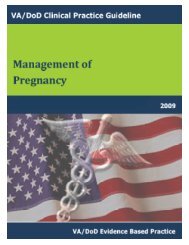DM Full Guideline (2010) - VA/DoD Clinical Practice Guidelines Home
DM Full Guideline (2010) - VA/DoD Clinical Practice Guidelines Home
DM Full Guideline (2010) - VA/DoD Clinical Practice Guidelines Home
You also want an ePaper? Increase the reach of your titles
YUMPU automatically turns print PDFs into web optimized ePapers that Google loves.
Version 4.0<br />
DISCUSSION<br />
<strong>VA</strong>/<strong>DoD</strong> <strong>Clinical</strong> <strong>Practice</strong> <strong>Guideline</strong><br />
for the Management of Diabetes Mellitus<br />
Singh et al. (2009) conducted a meta-analysis to compare the outcomes of insulin analogues with conventional<br />
insulins in the treatment of type 1, type 2 (adult and pediatric) and gestational diabetes. Authors concluded that<br />
rapid-and long-acting insulin analogues offer little benefit relative to conventional insulins in terms of glycemic<br />
control or reduced hypoglycemia.<br />
• In terms of hemoglobin HbA 1 c, there were minimal differences between rapid-acting insulin analogues and<br />
regular human insulin in adults with type 1 diabetes (weighted mean difference (WMD) for insulin lispro: -<br />
0.09%, 95% confidence interval [CI] -0.16% to -0.02%; for insulin aspart: -0.13%, 95% CI -0.20% to -<br />
0.07%). Similar outcomes were found among patients with type 2 diabetes (WMD for insulin lispro: -<br />
0.03%, 95% CI -0.12% to -0.06%; for insulin aspart: -0.09%, 95% CI -0.21% to 0.04%).<br />
• Differences between long-acting insulin analogues and NPH insulin in terms of HbA 1 c were also minimal<br />
among adults with type 1 diabetes (WMD for insulin glargine: -0.11%, 95% CI -0.21% to -0.02%; for<br />
insulin detemir: -0.06%, 95% CI -0.13% to 0.02%) and among adults with type 2 diabetes (WMD for<br />
insulin glargine: -0.05%, 95% CI -0.13% to 0.04%; for insulin detemir: 0.13%, 95% CI 0.03% to 0.22%).<br />
Benefits in terms of reduced hypoglycemia were inconsistent.<br />
Rapid (short)-acting insulin analogues vs. regular human insulin (RHI)<br />
A Cochrane review (Siebenhofer, et al., 2006) assessed the effects of short-acting insulin analogues versus regular<br />
human insulin. Authors concluded that there was only a minor benefit of short-acting insulin analogues in the<br />
majority of patients with diabetes over those treated with RHI.<br />
Mannucci et al. (2009) conducted a meta-analysis of RCTs and found that short-acting insulin analogues provided<br />
better control of HbA1c and postprandial glucose than RHI, without any significant reduction of the risk of severe<br />
hypoglycemia.<br />
• Short-acting analogues reduced HbA 1 c by 0.4% (0.1-0.6%) (p = 0.027) in comparison with RHI. A<br />
significant improvement was observed also in self-monitored 2 h post-breakfast and dinner blood glucose.<br />
• The overall rate of severe hypoglycemia was not significantly different between short-acting analogues and<br />
RHI.<br />
All of the short-acting insulins (analogues and RHI) are FDA approved for use in insulin pumps and may be used in<br />
continuous subcutaneous insulin infusion (CSII) therapy.<br />
Long acting insulin analogues vs. NPH.<br />
A Cochrane review (Vardi et al., 2008) assessed the effects of intermediate acting versus long acting insulin<br />
analogues for basal insulin replacement in patients with type 1 diabetes, and concluded that long acting insulin<br />
analogues seem to exert a beneficial effect on nocturnal glucose levels, but their effect on the overall diabetes<br />
control is clinically unremarkable.<br />
A Cochrane review (Horvath et al., 2007) assessed the effects of long-term treatment with long-acting insulin<br />
analogues (insulin glargine and insulin detemir) compared to NPH insulin in patients with type 2 diabetes mellitus.<br />
Authors concluded that, only a minor clinical benefit of treatment with long-acting insulin analogues for those<br />
patients treated with "basal" insulin regarding symptomatic nocturnal hypoglycemic events.<br />
Note: There are dosing differences between the long-acting analogues. Detemir is indicated for once daily or twice<br />
daily (BID) dosing and glargine is only indicated for once daily dosing. Glargine once daily dosing may be given at<br />
any time of the day, at the same time each day. However, detemir once daily dosing should be given with the<br />
evening meal or at bedtime. Twice daily dosing should be given with the evening meal, at bedtime, or 12 hours<br />
before the morning dose. Insulin requirements vary widely among people with diabetes, even when other factors are<br />
similar. Types, frequency, and dosages of insulin must be individualized, considering multiple factors. Below are<br />
recommendations from the manufactures on dosing in certain patients types. (Sources: Package inserts)<br />
Module G: Glycemic Control Page 62
















